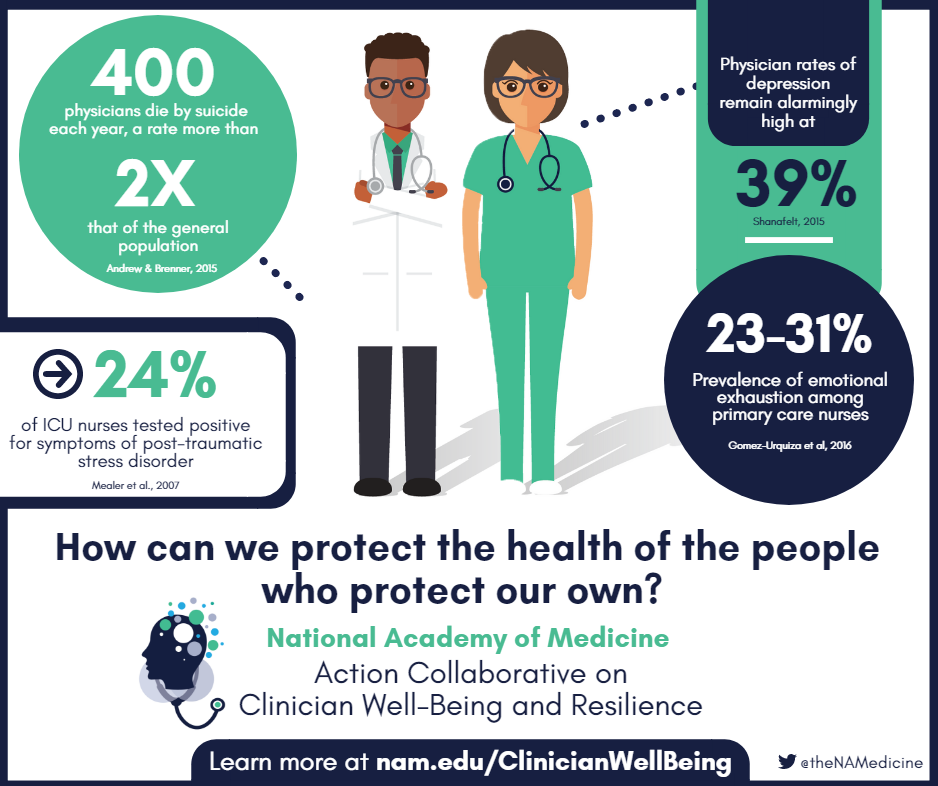Check out current research, resources, and solutions on the topic of Clinician Resilience and Well-Being!

Brought to you by your NHADACA Ethics Committee.
https://nam.edu/initiatives/clinician-resilience-and-well-being/
Clinician well-being is essential for safe, high-quality patient care.
However, clinicians of all kinds, across all specialties and care settings, are experiencing alarming rates of burnout. Among the most telling of statistics, more than 50 percent of U.S. physicians report significant symptoms. Burnout is a syndrome characterized by a high degree of emotional exhaustion and depersonalization (i.e., cynicism), and a low sense of personal accomplishment at work.
Clinician burnout can have serious, wide-ranging consequences, from reduced job performance and high turnover rates to—in the most extreme cases—medical error and clinician suicide. On the other hand, clinician well-being supports improved patient-clinician relationships, a high-functioning care team, and an engaged and effective workforce. In other words, when we invest in clinician well-being, everyone wins.
Supporting clinician well-being requires sustained attention and action at organizational, state, and national levels, as well as investment in research and information-sharing to advance evidence-based solutions.

About the Action Collaborative
In 2017, the National Academy of Medicine launched the Action Collaborative on Clinician Well-Being and Resilience, a network of more than 60 organizations committed to reversing trends in clinician burnout. The Collaborative has three goals:
- Raise the visibility of clinician anxiety, burnout, depression, stress, and suicide
- Improve baseline understanding of challenges to clinician well-being
- Advance evidence-based, multidisciplinary solutions to improve patient care by caring for the caregiver.
The Action Collaborative is composed of five working groups that will meet over the course of four years to identify evidence-based strategies to improve clinician well-being at both the individual and systems levels. Products and activities of these five working groups include an online knowledge hub, a series of NAM Perspectives discussion papers, and an all-encompassing conceptual model that reflects the domains affecting clinician well-being.
Gender-Based Differences in Burnout: Issues Faced by Women Physicians
Women now account for an increasingly large percentage of medical school students and practicing physicians, yet there is still a scarcity of research on how gender-related differences can affect clinician burnout and well-being. Recognizing gender-related differences is critical in designing effective strategies to improve clinician well-being and to identify, treat, and prevent burnout. This recently-released discussion paper examines how gender-related differences can manifest, and some strategies for ensuring well-being for all health professionals.
Expressions of Clinician Well-Being
The National Academy of Medicine recently called on artists of all skills and abilities to explore what clinician burnout, clinician well-being, and clinician resilience looks, feels and sounds like to people across the country. 100 pieces of artwork were selected by a panel of reviewers to be displayed in a digital gallery. Explore the digital art gallery >>
Clinician Well-Being Knowledge Hub is Live!
The Action Collaborative on Clinician Well-Being and Resilience is proud to announce the launch of the Clinician Well-Being Knowledge Hub, a comprehensive resource repository for those seeking to promote clinician well-being at their organizations and in their personal lives. Visit the knowledge hub>>
Help us share the knowledge hub by clicking here.

